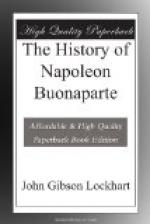On the 6th of April, Austria declared war; and on the 9th, the Archduke Charles, Generalissimo of armies which are said to have been recruited, at this period, to the amount of nearly 500,000 men, crossed the Inn at the head of six corps, each consisting of 30,000; while the Archduke John marched with two other divisions towards Italy, by the way of Carinthia; and the Archduke Ferdinand assumed the command of a ninth corps in Galicia, to make head against Russia, in case that power should be forced or tempted by Napoleon to take part in the struggle. Napoleon, having so great an army in Spain, could not hope to oppose numbers such as these to the Austrians; but he trusted to the rapid combinations which had so often enabled him to baffle the same enemy; and the instant he ascertained that Bavaria was invaded by the Archduke Charles, he proceeded, without guards, without equipage, accompanied solely by the faithful Josephine, to Frankfort, and thence to Strasbourg. He assumed the command on the 13th, and immediately formed the plan of his campaign.
He found the two wings of his army, the one under Massena, the other under Davoust, at such a distance from the centre that, if the Austrians had seized the opportunity, the consequences might have been fatal. On the 17th of April, he commanded Davoust and Massena to march simultaneously towards a position in front, and then pushed forward the centre, in person, to the same point. The Archduke Lewis, who commanded two Austrian divisions in advance, was thus hemmed in unexpectedly by three armies, moving at once from three different points; defeated and driven back, at Abensberg, on the 20th; and utterly routed, at Landshut, on the 21st. Here the Archduke lost 9000 men, thirty guns, and all his stores.
Next day Buonaparte executed a variety of movements, considered as among the most admirable displays of his science, by means of which he brought his whole force, by different routes, at one and the same moment upon the position of the Archduke Charles. That prince was strongly posted at Eckmuhl, with full 100,000 men. Napoleon charged him at two in the afternoon; the battle was stern and lasted till nightfall, but it ended in a complete overthrow. The Austrians, besides their loss in the field, left in Napoleon’s hands 20,000 prisoners, fifteen colours, and the greater part of their artillery; and retreated in utter disorder upon Ratisbonne. The Archduke made an attempt to rally his troops and defend that city, on the 23rd; but the French stormed the walls and drove the Austrians through the streets: and their general immediately retreated into Bohemia: thus; in effect, abandoning Vienna to the mercy of his conqueror.




